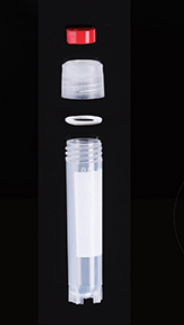
Cryo Vials, also known as cryogenic vials, are small, cylindrical containers used to store biological samples at very low temperatures. They are typically made of polypropylene, which is a durable and chemically-resistant plastic that can withstand extreme temperatures. Cryo Vials come in various sizes and colors, and are designed to be compatible with a variety of storage systems, such as racks and boxes.
Structure of Cryo Vials
Cryo vials are made up of several parts, each of which plays an important role in their overall structure and function:
Cap: The cap is the top part of the vial that seals the contents inside. It is typically made of polyethylene, which is a flexible and airtight plastic. The cap may have a variety of features, such as a silicone gasket for added sealing, a writing area for labeling, or a tab for easy opening.
Body: The body of the vial is the main storage compartment for the sample. It is typically made of polypropylene, which is a rigid and durable plastic that can withstand low temperatures. The body may have various features, such as graduations for measuring sample volumes, or a frosted area for labeling.
Skirt: The skirt is the bottom part of the vial that provides stability and support. It is typically wider than the body of the vial, and may have a variety of features, such as ridges for easy handling or a locking mechanism for securing the vial in a storage system.
How to Use Cryo Vials
Using cryo vials is a straightforward process, but there are a few important steps to follow to ensure that your samples are stored safely and securely:
Label your vials: Before adding any samples to your cryo vials, it's important to label them with the necessary information, such as the sample type, date, and any other relevant details. You can use a permanent marker to write directly on the vial, or use labels or stickers designed for cryo vials.
Prepare your samples: Once your vials are labeled, you can prepare your samples for storage. Depending on the type of sample, you may need to add a cryoprotectant solution to prevent damage from freezing. You should also make sure that your samples are at the appropriate temperature before adding them to the vials.
Fill your vials: Carefully Pipette or pour your samples into the cryo vials, making sure not to overfill them. Leave a small amount of headspace at the top of the vial to allow for expansion during freezing.
Seal your vials: Once your vials are filled, place the caps securely onto the top of the vials. Make sure that the caps are tightened enough to provide a good seal, but not so tight that they are difficult to remove later.
Store your vials: Finally, place your cryo vials into a storage system that is appropriate for your needs. This could be a rack, box, or other type of container designed for cryogenic storage. Make sure that your storage system is properly labeled and organized for easy retrieval later.
By following these steps, you can ensure that your samples are stored safely and securely in cryo vials. Whether you are working in a research lab, clinical setting, or other environment, cryo vials are an essential tool for preserving biological samples for future analysis.
Contact: Neo
Phone: 008615867460640
E-mail: Info@Hwtai.com
Whatsapp:008615867460640
Add: Building 2, Xinmao Qilu Science Technology Industrial Park, Tianqiao District, Jinan City, Shandong Province,China.
We chat
